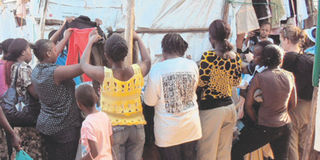‘Mitumba’ market where items are cheap and trendy

Buyers rummage through stacks of clothes at Toi market. Photo/ELVIS OGINA
It is a fine Saturday morning and Jacinta Awour is busy putting final touches on the display of her wares in a stall at Toi market in Kibera; arranging lingerie on a wooden table.
If this turns out to be a good day, she will sell 120 pieces and debit her account with Sh6,000. Several women stop by, examine the bras and panties and inquire about the price.
A bra costs Sh50 as does panties. No bargaining. Several women reach for their purses. In shops like Woolworths, a new bra could cost as much as Sh4,500.
Selling women’s clothes at Toi market is a booming business, and Ms Awuor says second-hand lingerie is in high demand.
She has had a stall in the open-air market off Ngong Road for three years and buys her goods at the Gikomba open-air market.
A bale of bras costs her Sh40,000 and another of panties Sh20,000.
Second-hand underwear
According to her, women don’t have a problem buying second-hand underwear, which she buys “in camera” — meaning dealers give her a choice from the best items they have.
The Toi traders have worked out deals with their Gikomba counterparts to have first look when the mitumba bales arrive.
Ms Awuor is one of dozens of traders at the vast Toi market which, unlike the more congested Gikomba and Ngara markets in the east of Nairobi, draws a wealthier and more diverse clientele.
This is because most of the shoppers there consider it more secure and with less hassles than the other open-air markets.
The market, which began in 1992 as a food centre where people coming to the Kibera law courts could stop for a bite, has become a vast emporium of second-hand lingerie, tops, dresses, shirts and jeans.
Women shoppers interviewed said they often find the contemporary and trendy—and cheap—mitumba that no one else has.
For them, Toi offers a variety of unique clothes some of which are trending in the fashion capitals of the West. And the prices are world’s apart.
Toi also serves as a secondary market for the exhibition stalls mushrooming in the city centre.
“There are very many of them that we supply with clothes,” said a trader who would not give his name for fear of compromising his business.
Dorcas Mueni, who sells wome’s clothes there, has established a personal relationship with her customers.
Indeed, when something unique arrives, she figures out whom it would perfectly fit and calls her.
On the day Lifestyle visited Toi, two young women were disappointed that they could not find what they were looking for, but Ms Mueni promised to call them as soon as she got new stock.
New arrivals
“I always keep in touch with my closest customers and call them whenever I have new arrivals,” she explained.
Gikomba was the original mitumba market that drew shoppers from across the city. But as the second-hand clothing business expanded with the arrival of factory rejects that are, in fact, new clothes, and a wider selection of the latest fashion, markets like Ngara and Toi started.
But it is Toi that draws the “international customers”—expatriate women who would feel uncomfortable amid the jostling and hustling in the other open-air markets.
“The clothes are good and cheap, similar to the ones that I can find at a shop in New York,” said a white woman who only identified herself as Jennifer.
Much of Toi market was destroyed by fire during the post-election violence in early 2008. But today it is back with 2,000 numbered stalls, thanks in part to Jamii Bora, a local NGO that contributed iron sheets towards the reconstruction.
Traders pay a daily levy of Sh25 to the city council. This means the City Council of Nairobi earns Sh1.5 million per day from the traders.
Furthermore, with many stalls selling an average of 100 items a day at a cost of Sh200-Sh800, this indicates that at least Sh12 million circulates in the market in a day.
“In 2007, the market was disorganised, and we didn’t have good accessibility and drainage. During the reconstruction, well-wishers provided us with an engineer who advised us on the order of the stalls,” said the market’s secretary Aloyce Ouma.
After the post-election violence, he said, many people thought Toi was history and avoided it out of fear for their safety.
Recently, 50 stalls were destroyed by a fire that broke out near the Jua Kali section of the market.
Market chairman Ezekiel Rema says Toi is a one-stop shop where everything a shopper could want is available.
Mr Ouma, a father of three who grew up in the neighbourhood and set up his stall in 1997, said the market took its name from the nearby Toi Primary School.
But not all shoppers leave Toi market satisfied. A few women on their first visit complained about exorbitant prices and said the market did not have the kind of clothes they were looking for.




